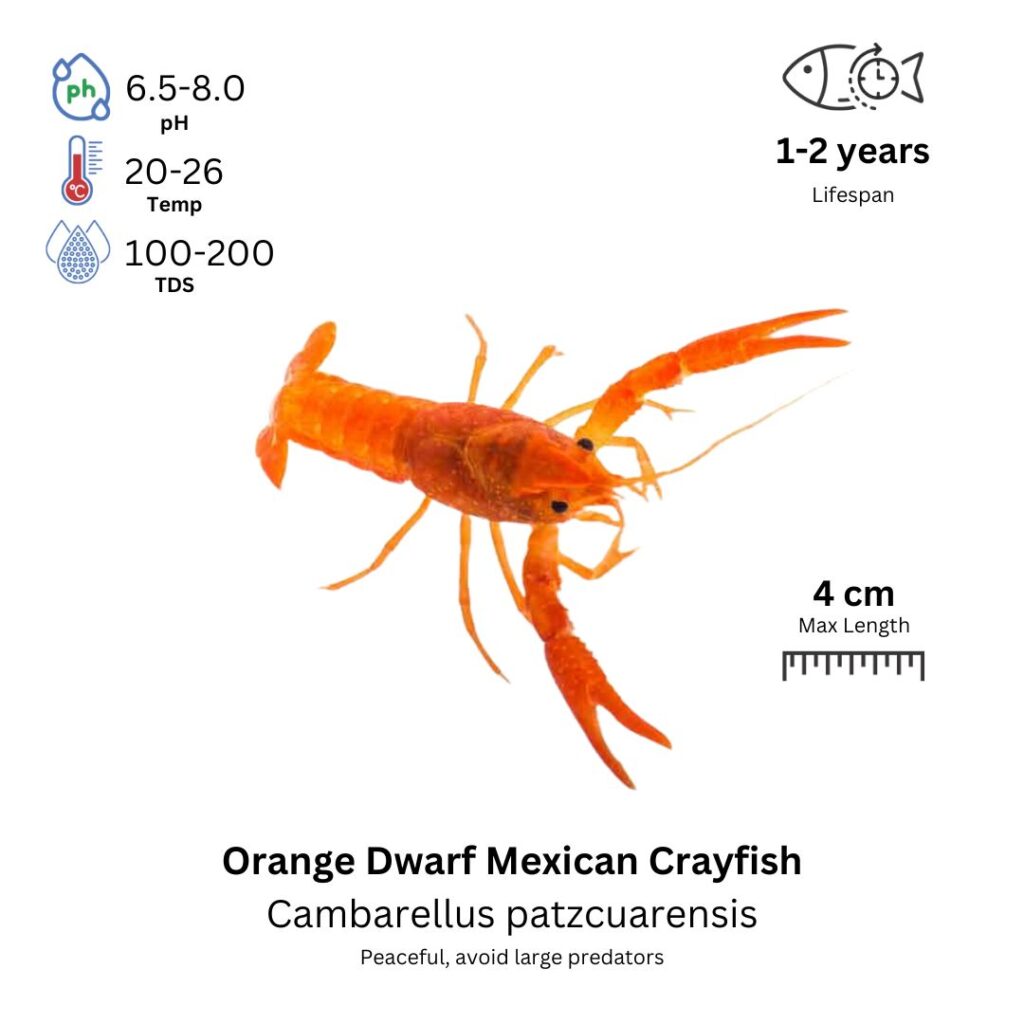Orange Dwarf Mexican Crayfish
Cambarus patzcuarensis

Description
The Orange Dwarf Mexican Crayfish is a vibrant and small freshwater crayfish species that is popular among aquarium enthusiasts due to its striking orange coloration. These crayfish have a compact, rounded body with bright orange or reddish-orange exoskeletons, which makes them stand out in the tank. Their claws, legs, and body often have a contrasting lighter color with a mix of darker spots or patterns. Males are typically more colorful and slightly larger than females. These crayfish are peaceful and can be active swimmers, but they tend to spend most of their time burrowing into the substrate or hiding under rocks and decorations. They are also excellent scavengers, helping to keep the tank clean by consuming detritus, leftover food, and algae.
Habitat Origin
Native to the lakes and streams of Mexico, particularly in the area around Lake Patzcuaro in central Mexico. They prefer slow-moving, clear waters with a soft substrate like sand or fine gravel, and they thrive in environments with moderate water flow and plenty of hiding spots.
Aquarium
Ideal Number in Aquarium: One per tank or a small group if the tank is large enough to allow for territorial behavior.
Favorite Food

Orange Dwarf Mexican Crayfish are omnivores and will consume a variety of foods, including algae, detritus, sinking pellets, live or frozen foods like bloodworms, daphnia, and small pieces of vegetables such as zucchini or spinach. They also enjoy scavenging on leftover fish food and eating decaying plant matter. Providing them with a balanced diet will help maintain their vibrant coloration and health.
Behavior:
These crayfish are generally peaceful, but they can become territorial, especially during molting or if resources like hiding spots are scarce. They are less aggressive than larger crayfish species, but they may show aggression toward other crayfish or smaller fish, especially if there is not enough space or shelter in the tank. Orange Dwarf Mexican Crayfish are more active at night and may spend most of the day hiding under rocks, plants, or aquarium decorations. They are fascinating to watch, as they will often rearrange the substrate and explore their environment.
Special Care:
These crayfish need a well-planted tank with plenty of hiding spots, such as caves, rocks, and driftwood, as they prefer to feel secure. A fine-gravel or sandy substrate is recommended, as it is easier for them to burrow into and less likely to harm their delicate antennae. They can be sensitive to water quality, so regular water changes and good filtration are essential to keep their environment clean and stable. It is also important to ensure that the tank has a secure lid, as they are known to be capable climbers and may escape if the tank is not covered.
Compatibility with Other Fish:
Orange Dwarf Mexican Crayfish can be kept with peaceful fish that will not disturb them or threaten their territory. They do well with small, non-aggressive fish like tetras, guppies, or rasboras. However, they should not be kept with other crayfish or large, aggressive species that may intimidate them or pose a threat to their safety. Care should be taken when keeping them with small fish, as the crayfish might view them as food. The best tankmates are those that swim in different areas of the tank or are too large to be considered prey.
Breeding Tank Setup
Using a separate breeding tank is strongly recommended for Orange Dwarf Mexican Crayfish to maintain controlled conditions and minimize predation on eggs or fry. A 10-gallon tank (38 liters) is suitable for a small group, while a 20-gallon (75 liters) tank is ideal for multiple pairs. Maintain stable water parameters: pH 7.0–8.5, temperature 22–28°C (72–82°F), and hardness 6–12 dGH. Use fine gravel or sand for burrowing, and provide plenty of hiding spots such as rocks, driftwood, and small caves. Java moss or other soft plants offer surfaces for eggs and shelter for fry. Moderate lighting on a 12-hour cycle is best, avoiding excessive brightness.
Conditioning for Breeding
To prepare crayfish for breeding, offer a balanced, protein-rich diet. Feed high-quality sinking pellets or algae wafers, along with live or frozen foods like brine shrimp, bloodworms, or daphnia. Supplement with blanched vegetables such as zucchini, peas, or spinach. A high-protein intake is particularly important for females preparing to produce eggs. Conduct weekly 20–30% water changes, and to encourage spawning, perform a larger 50% change and raise the temperature slightly to 28°C (82°F) to mimic natural breeding triggers.
Spawning Behavior
Spawning usually occurs shortly after the female molts, at which point the male deposits sperm and the female lays eggs. A single female can produce 20–40 eggs, which she carries under her tail (pleopods) until hatching. Parental separation is optional but may be necessary if adults show signs of cannibalism, especially under stress or when food is scarce. In stable conditions, the mother may successfully raise the fry in-tank, although monitoring behavior closely is advised.
Fry Development & Feeding
Eggs take 3–4 weeks to hatch, depending on temperature. Fry will initially depend on yolk sacs for nourishment. Once free-swimming, feed them infusoria or liquid fry food, then baby brine shrimp or microworms as they grow. Crayfish fry also forage on biofilm, algae, and fine detritus, so maintaining a mature, well-balanced tank is beneficial. Perform daily or alternate-day water changes of 10–20%, and avoid overfeeding, which can degrade water quality and lead to fry mortality.
Additional Breeding Tips & Identification
Orange Dwarf Mexican Crayfish reach sexual maturity at 6–12 months. Males are smaller, more colorful, and may show thicker claws. Females are broader and visibly carry eggs under the tail during reproduction. Avoid stressors such as sudden water parameter changes, overcrowding, and aggressive tank mates, as these can negatively impact breeding success. Clean, well-oxygenated water and a calm, spacious tank environment are key to maintaining a healthy and productive breeding colony.
